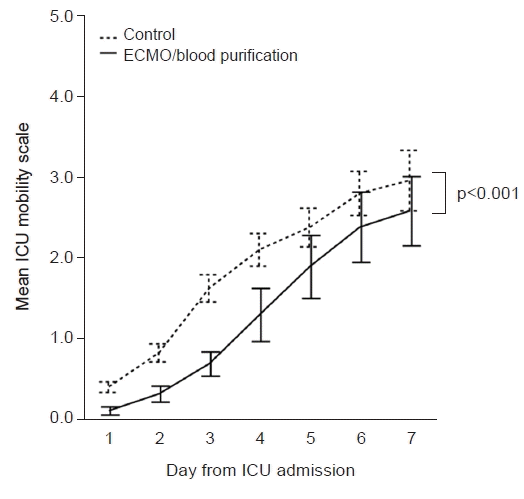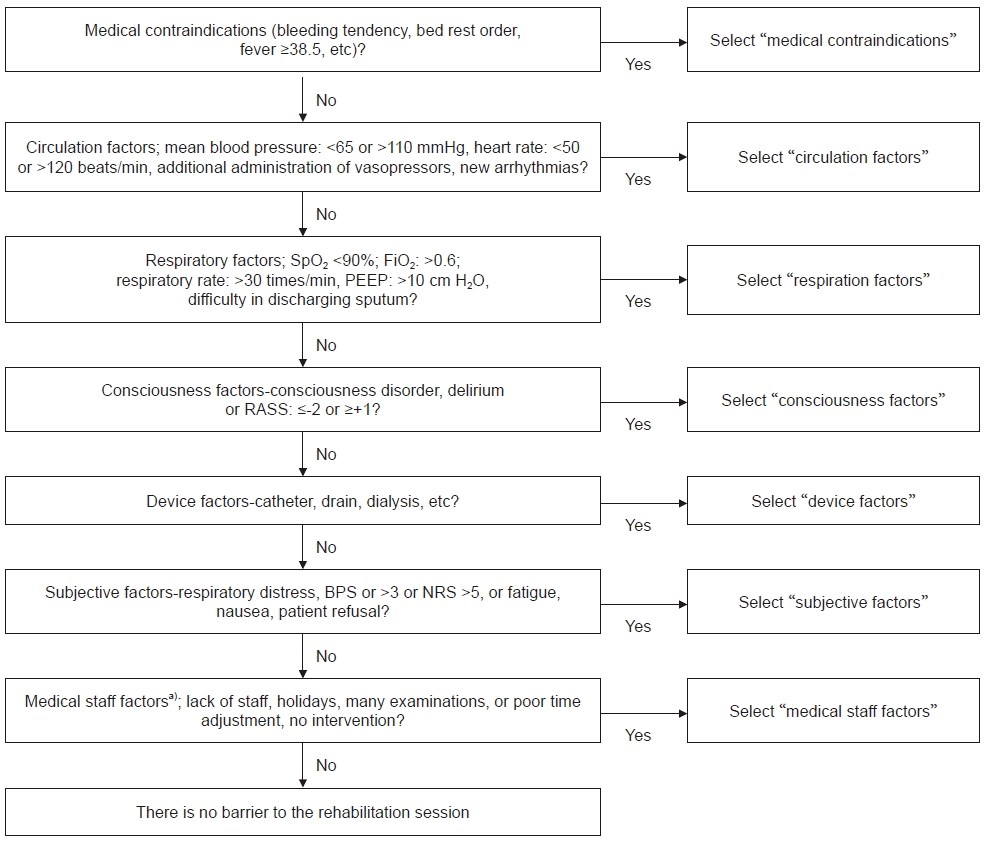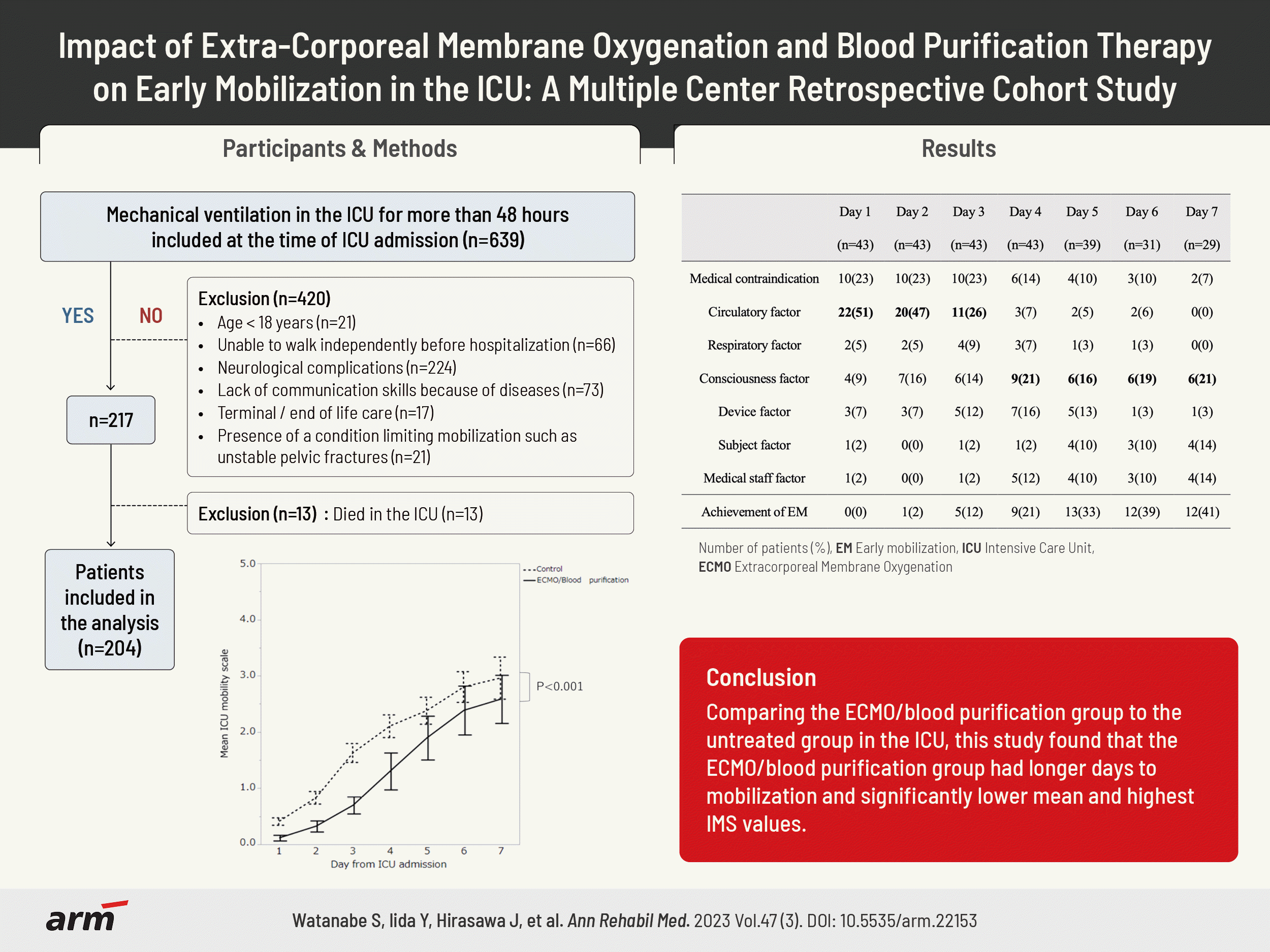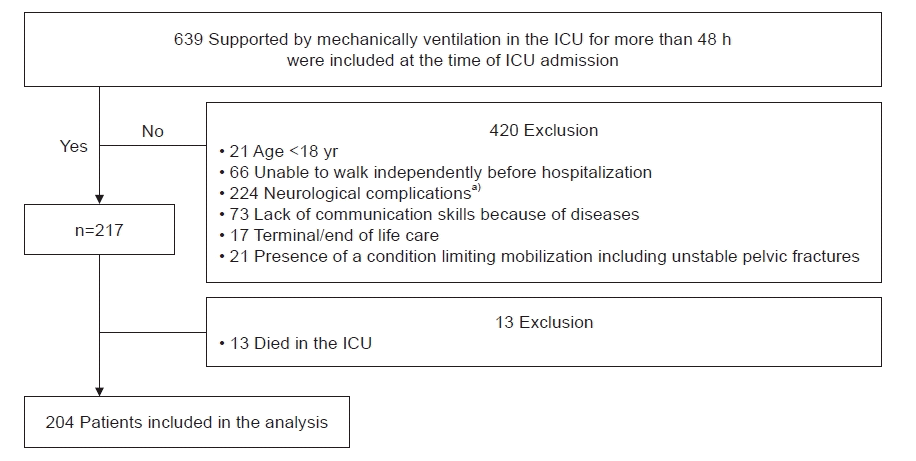1. Needham DM, Davidson J, Cohen H, Hopkins RO, Weinert C, Wunsch H, et al. Improving long-term outcomes after discharge from intensive care unit: report from a stakeholders' conference. Crit Care Med. 2012; 40:502–9.
2. Ministry of Health, Labor and Welfare (Japan). Reiwa 4-year Revision of Medical Fees I-3-9. Revision of the upper limit of calculation days for emergency hospitalization charges [Internet]. Tokyo: Ministry of Health, Labor and Welfare;2022. [cited 2022 Oct 10]. Available from:
https://www.mhlw.go.jp/stf/seisakunitsuite/bunya/0000188411_00037.html.
3. Schweickert WD, Pohlman MC, Pohlman AS, Nigos C, Pawlik AJ, Esbrook CL, et al. Early physical and occupational therapy in mechanically ventilated, critically ill patients: a randomised controlled trial. Lancet. 2009; 373:1874–82.

4. Morris PE, Berry MJ, Files DC, Thompson JC, Hauser J, Flores L, et al. Standardized rehabilitation and hospital length of stay among patients with acute respiratory failure: a randomized clinical trial. JAMA. 2016; 315:2694–702.

5. Watanabe S, Liu K, Nakamura K, Kozu R, Horibe T, Ishii K, et al. Association between early mobilization in the ICU and psychiatric symptoms after surviving a critical illness: a multi-center prospective cohort study. J Clin Med. 2022; 11:2587.

6. Watanabe S, Kotani T, Taito S, Ota K, Ishii K, Ono M, et al. Determinants of gait independence after mechanical ventilation in the intensive care unit: a Japanese multicenter retrospective exploratory cohort study. J Intensive Care. 2019; 7:53.

7. Ad Hoc Committee for Early Rehabilitation; The Japanese Society of Intensive Care Medicine. [Evidence based expert consensus for early rehabilitation in the intensive care unit]. J Jpn Soc Intensive Care Med. 2017; 24:255–303. Japanese.
8. Watanabe S, Liu K, Morita Y, Kanaya T, Naito Y, Arakawa R, et al. Changes in barriers to implementing early mobilization in the intensive care unit: a single center retrospective cohort study. Nagoya J Med Sci. 2021; 83:443–64.
9. Yasuda H, Kato A, Fujigaki Y, Hishida A; Shizuoka Kidney Disease Study Group. Incidence and clinical outcomes of acute kidney injury requiring renal replacement therapy in Japan. Ther Apher Dial. 2010; 14:541–6.

10. Hodgson C, Needham D, Haines K, Bailey M, Ward A, Harrold M, et al. Feasibility and inter-rater reliability of the ICU Mobility Scale. Heart Lung 2014;43:19-24. Erratum in: Heart Lung. 2014; 43:388.
11. Hermans G, Casaer MP, Clerckx B, Güiza F, Vanhullebusch T, Derde S, et al. Effect of tolerating macronutrient deficit on the development of intensive-care unit acquired weakness: a subanalysis of the EPaNIC trial. Lancet Respir Med. 2013; 1:621–9.

12. Ely EW, Margolin R, Francis J, May L, Truman B, Dittus R, et al. Evaluation of delirium in critically ill patients: validation of the Confusion Assessment Method for the Intensive Care Unit (CAM-ICU). Crit Care Med. 2001; 29:1370–9.

13. Watanabe S, Morita Y, Suzuki S, Kochi K, Ohno M, Liu K, et al. Effects of the intensity and activity time of early rehabilitation on activities of daily living dependence in mechanically ventilated patients. Prog Rehabil Med. 2021; 6:20210054.

14. Watanabe S, Iida Y, Ito T, Mizutani M, Morita Y, Suzuki S, et al. Effect of early rehabilitation activity time on critically Ill patients with intensive care unit-acquired weakness: a Japanese retrospective multicenter study. Prog Rehabil Med. 2018; 3:20180003.

15. Suzuki M, Oya H, Ishihara Y. [Practice of ICU nurses caring for patients undergoing blood purification therapy: the approach at our ICU]. J Jpn Soc Blood Purif Crit Care. 2020; 11:128–32. Japanese.
16. Scheffenbichler FT, Teja B, Wongtangman K, Mazwi N, Waak K, Schaller SJ, et al. Effects of the level and duration of mobilization therapy in the surgical ICU on the loss of the ability to live independently: an international prospective cohort study. Crit Care Med. 2021; 49:e247–57.

17. TEAM Study Investigators and the ANZICS Clinical Trials Group. Early active mobilization during mechanical ventilation in the ICU. N Engl J Med. 2022; 387:1747–58.
18. Ministry of Health, Labor and Welfare (Japan). Central social insurance medical council general assembly (493rd) proceedings. Source: 2019 DPC data [Internet. Tokyo: Ministry of Health, Labor and Welfare;2022. [cited 2022 Oct 10]. Available from:
https://www.mhlw.go.jp/stf/shingi2/0000212500_00115.html.
19. Watanabe S, Hirasawa J, Naito Y, Mizutani M, Uemura A, Nishimura S, et al. Association between the early mobilization of mechanically ventilated patients and independence in activities of daily living at hospital discharge. Sci Rep. 2023; 13:4265.

20. TEAM Study Investigators. Early mobilization and recovery in mechanically ventilated patients in the ICU: a bi-national, multi-centre, prospective cohort study. Crit Care. 2015; 19:81.
21. Devlin JW, Skrobik Y, Gélinas C, Needham DM, Slooter AJC, Pandharipande PP, et al. Clinical practice guidelines for the prevention and management of Pain, Agitation/Sedation, Delirium, Immobility, and Sleep disruption in adult patients in the ICU. Crit Care Med. 2018; 46:e825–73.






 PDF
PDF Citation
Citation Print
Print





 XML Download
XML Download